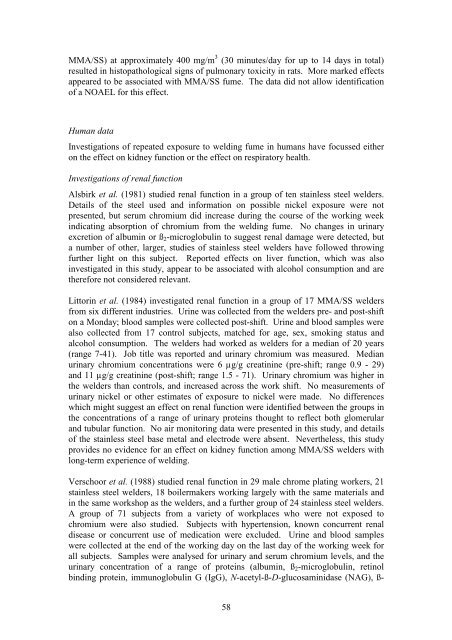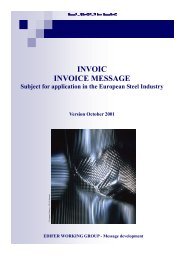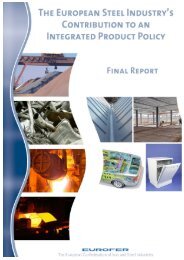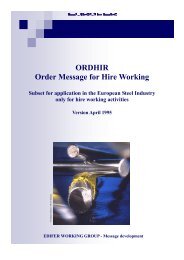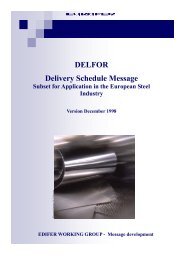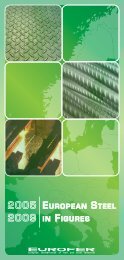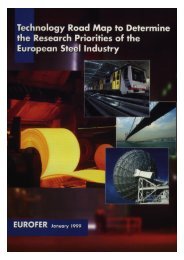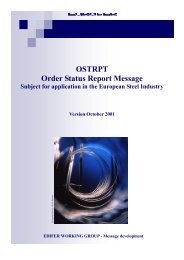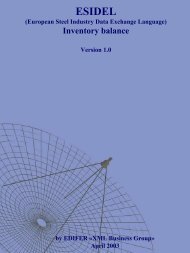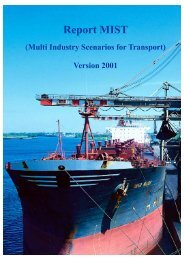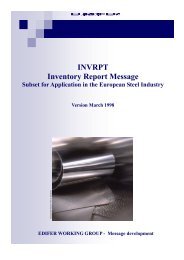manufacture, processing and use of stainless steel - International ...
manufacture, processing and use of stainless steel - International ...
manufacture, processing and use of stainless steel - International ...
Create successful ePaper yourself
Turn your PDF publications into a flip-book with our unique Google optimized e-Paper software.
MMA/SS) at approximately 400 mg/m 3 (30 minutes/day for up to 14 days in total)<br />
resulted in histopathological signs <strong>of</strong> pulmonary toxicity in rats. More marked effects<br />
appeared to be associated with MMA/SS fume. The data did not allow identification<br />
<strong>of</strong> a NOAEL for this effect.<br />
Human data<br />
Investigations <strong>of</strong> repeated exposure to welding fume in humans have focussed either<br />
on the effect on kidney function or the effect on respiratory health.<br />
Investigations <strong>of</strong> renal function<br />
Alsbirk et al. (1981) studied renal function in a group <strong>of</strong> ten <strong>stainless</strong> <strong>steel</strong> welders.<br />
Details <strong>of</strong> the <strong>steel</strong> <strong>use</strong>d <strong>and</strong> information on possible nickel exposure were not<br />
presented, but serum chromium did increase during the course <strong>of</strong> the working week<br />
indicating absorption <strong>of</strong> chromium from the welding fume. No changes in urinary<br />
excretion <strong>of</strong> albumin or ß2-microglobulin to suggest renal damage were detected, but<br />
a number <strong>of</strong> other, larger, studies <strong>of</strong> <strong>stainless</strong> <strong>steel</strong> welders have followed throwing<br />
further light on this subject. Reported effects on liver function, which was also<br />
investigated in this study, appear to be associated with alcohol consumption <strong>and</strong> are<br />
therefore not considered relevant.<br />
Littorin et al. (1984) investigated renal function in a group <strong>of</strong> 17 MMA/SS welders<br />
from six different industries. Urine was collected from the welders pre- <strong>and</strong> post-shift<br />
on a Monday; blood samples were collected post-shift. Urine <strong>and</strong> blood samples were<br />
also collected from 17 control subjects, matched for age, sex, smoking status <strong>and</strong><br />
alcohol consumption. The welders had worked as welders for a median <strong>of</strong> 20 years<br />
(range 7-41). Job title was reported <strong>and</strong> urinary chromium was measured. Median<br />
urinary chromium concentrations were 6 µg/g creatinine (pre-shift; range 0.9 - 29)<br />
<strong>and</strong> 11 µg/g creatinine (post-shift; range 1.5 - 71). Urinary chromium was higher in<br />
the welders than controls, <strong>and</strong> increased across the work shift. No measurements <strong>of</strong><br />
urinary nickel or other estimates <strong>of</strong> exposure to nickel were made. No differences<br />
which might suggest an effect on renal function were identified between the groups in<br />
the concentrations <strong>of</strong> a range <strong>of</strong> urinary proteins thought to reflect both glomerular<br />
<strong>and</strong> tubular function. No air monitoring data were presented in this study, <strong>and</strong> details<br />
<strong>of</strong> the <strong>stainless</strong> <strong>steel</strong> base metal <strong>and</strong> electrode were absent. Nevertheless, this study<br />
provides no evidence for an effect on kidney function among MMA/SS welders with<br />
long-term experience <strong>of</strong> welding.<br />
Verschoor et al. (1988) studied renal function in 29 male chrome plating workers, 21<br />
<strong>stainless</strong> <strong>steel</strong> welders, 18 boilermakers working largely with the same materials <strong>and</strong><br />
in the same workshop as the welders, <strong>and</strong> a further group <strong>of</strong> 24 <strong>stainless</strong> <strong>steel</strong> welders.<br />
A group <strong>of</strong> 71 subjects from a variety <strong>of</strong> workplaces who were not exposed to<br />
chromium were also studied. Subjects with hypertension, known concurrent renal<br />
disease or concurrent <strong>use</strong> <strong>of</strong> medication were excluded. Urine <strong>and</strong> blood samples<br />
were collected at the end <strong>of</strong> the working day on the last day <strong>of</strong> the working week for<br />
all subjects. Samples were analysed for urinary <strong>and</strong> serum chromium levels, <strong>and</strong> the<br />
urinary concentration <strong>of</strong> a range <strong>of</strong> proteins (albumin, ß2-microglobulin, retinol<br />
binding protein, immunoglobulin G (IgG), N-acetyl-ß-D-glucosaminidase (NAG), ß-<br />
58


